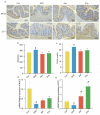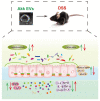Effect of Extracelluar Vesicles Derived from Akkermansia muciniphila on Intestinal Barrier in Colitis Mice
- PMID: 38004116
- PMCID: PMC10674789
- DOI: 10.3390/nu15224722
Effect of Extracelluar Vesicles Derived from Akkermansia muciniphila on Intestinal Barrier in Colitis Mice
Abstract
Inflammatory bowel disease (IBD) is a chronic and recurrent disease. It has been observed that the incidence and prevalence of IBD are increasing, which consequently raises the risk of developing colon cancer. Recently, the regulation of the intestinal barrier by probiotics has become an effective treatment for colitis. Akkermansia muciniphila-derived extracellular vesicles (Akk EVs) are nano-vesicles that contain multiple bioactive macromolecules with the potential to modulate the intestinal barrier. In this study, we used ultrafiltration in conjunction with high-speed centrifugation to extract Akk EVs. A lipopolysaccharide (LPS)-induced RAW264.7 cell model was established to assess the anti-inflammatory effects of Akk EVs. It was found that Akk EVs were able to be absorbed by RAW264.7 cells and significantly reduce the expression of nitric oxide (NO), TNF-α, and IL-1β (p < 0.05). We explored the preventative effects on colitis and the regulating effects on the intestinal barrier using a mouse colitis model caused by dextran sulfate sodium (DSS). The findings demonstrated that Akk EVs effectively prevented colitis symptoms and reduced colonic tissue injury. Additionally, Akk EVs significantly enhanced the effectiveness of the intestinal barrier by elevating the expression of MUC2 (0.53 ± 0.07), improving mucus integrity, and reducing intestinal permeability (p < 0.05). Moreover, Akk EVs increased the proportion of the beneficial bacteria Firmicutes (33.01 ± 0.09%) and downregulated the proportion of the harmful bacteria Proteobacteria (0.32 ± 0.27%). These findings suggest that Akk EVs possess the ability to regulate immune responses, protect intestinal barriers, and modulate the gut microbiota. The research presents a potential intervention approach for Akk EVs to prevent colitis.
Keywords: Akkermansia muciniphila; colitis; extracellular vesicles; gut microbiota; intestinal barrier; prevention.
Conflict of interest statement
The authors have no competing interests to declare. All authors give their approval for the publication of this manuscript.
Figures










References
-
- Franzosa E.A., Sirota-Madi A., Avila-Pacheco J., Fornelos N., Haiser H.J., Reinker S., Vatanen T., Hall A.B., Mallick H., McIver L.J., et al. Gut Microbiome Structure and Metabolic Activity in Inflammatory Bowel Disease. Nat. Microbiol. 2018;4:293–305. doi: 10.1038/s41564-018-0306-4. - DOI - PMC - PubMed
MeSH terms
Substances
Supplementary concepts
Grants and funding
LinkOut - more resources
Full Text Sources
Molecular Biology Databases
Miscellaneous

